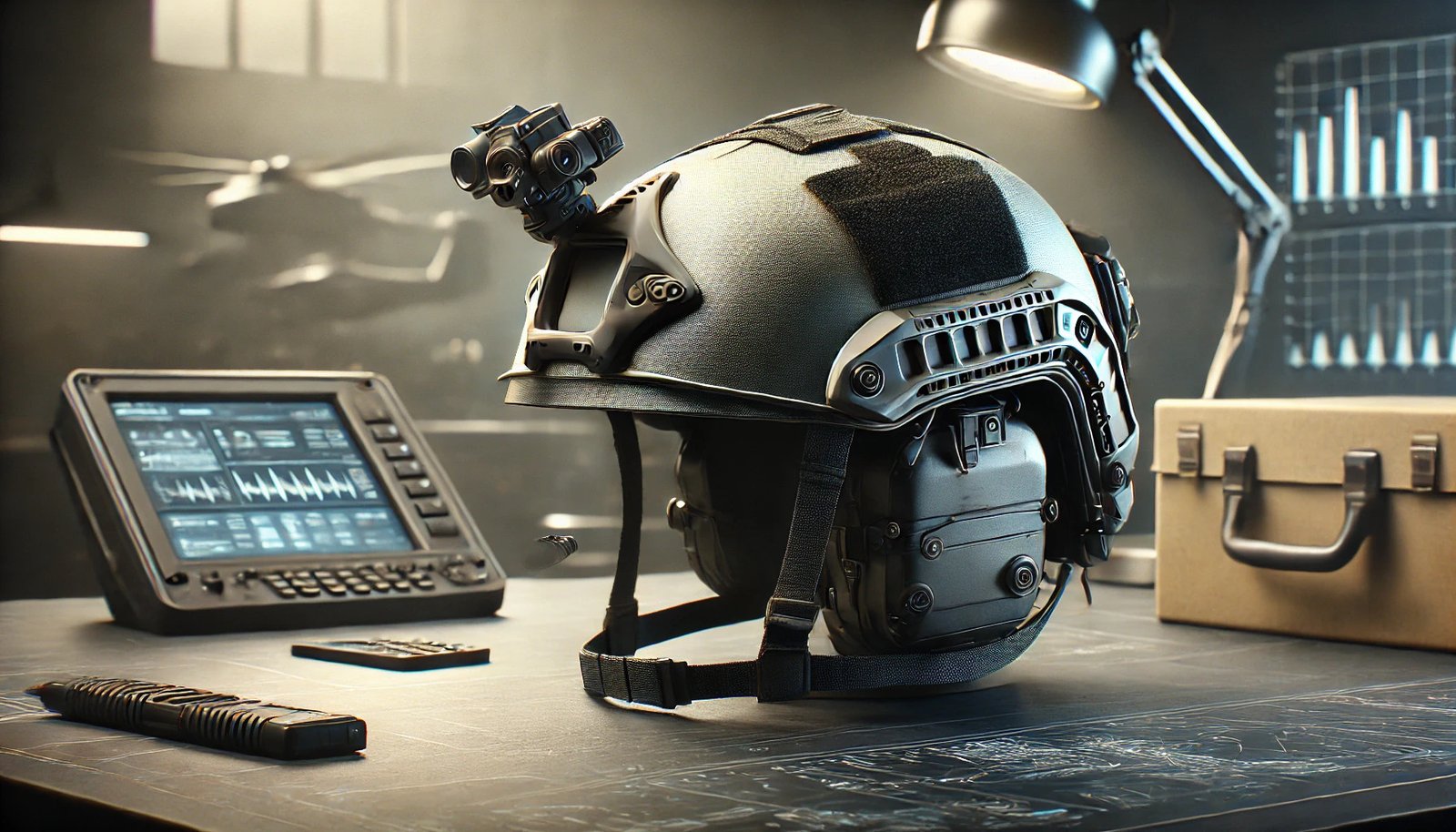Introduction
The Global Military Helmet Market is experiencing significant growth, driven by advancements in technology, increasing defense budgets, and a strong focus on soldier modernization programs. With a market valuation of USD 2.40 billion in 2023, the military helmet industry is projected to grow to USD 3.76 billion by 2029, reflecting a robust compound annual growth rate (CAGR) of 7.84%. This surge in demand is largely fueled by the continuous evolution of military gear, particularly helmets, which are transitioning from simple protective headgear to highly sophisticated combat systems that integrate cutting-edge technologies. For businesses looking to capitalize on this growth, understanding the key drivers of this market and the strategic opportunities available will be critical.

Market Overview
The military helmet market has evolved dramatically in recent years, driven by the need for advanced protective gear that meets the changing demands of modern warfare. Military operations have become more complex, requiring helmets that not only protect soldiers from ballistic threats but also enhance their operational capabilities through integrated technologies like communication systems, night vision capabilities, and heads-up displays (HUDs).
Military Helmet Evolution
The evolution of military helmets from basic protection to advanced combat systems is a key driver of market growth. Early helmets, designed solely for head protection, have been transformed into multifunctional tools that improve communication, situational awareness, and tactical decision-making on the battlefield. This transformation is largely attributed to advancements in materials science, which has led to the development of lighter, more durable helmets made from materials like Kevlar, carbon fiber, and ultra-high-molecular-weight polyethylene (UHMWPE).
Growth in the Military Helmet Market (2023-2029)
The market’s growth, with a 7.84% CAGR, indicates a significant opportunity for manufacturers, suppliers, and investors in the defense industry. With global defense budgets increasing, particularly in regions such as North America, Asia-Pacific, and Europe, the demand for advanced military helmets is expected to rise steadily over the next few years. As more countries modernize their armed forces and adopt new defense technologies, the military helmet market will continue to expand, offering lucrative business opportunities.
Key Drivers of Growth in the Global Military Helmet Market
The growth of the military helmet market can be attributed to several key factors, which are shaping the market landscape and creating opportunities for businesses and investors alike. These factors include technological advancements, increased global defense spending, and a growing emphasis on soldier modernization programs.
Technological Advancements in Military Helmets
One of the most important drivers of growth in the global military helmet market is the rapid pace of technological advancements. Modern military helmets are no longer just protective gear; they are becoming integrated combat systems that significantly enhance a soldier’s operational capabilities. Here are some of the most impactful technological innovations transforming the market:
Advanced Materials for Lightweight and Durable Helmets
Materials science has played a critical role in the development of modern military helmets. Traditional helmets made from steel or heavy composites have been replaced by helmets made from lighter, stronger materials such as Kevlar, carbon fiber, and UHMWPE. These materials offer superior ballistic protection while reducing the overall weight of the helmet, which is crucial for improving soldier mobility and comfort during extended missions.
Integration of Communication Tools
Another key innovation is the integration of communication tools directly into military helmets. These systems allow soldiers to maintain real-time communication with their units, share information quickly, and receive mission-critical updates without the need for separate radio devices. This enhances coordination and operational efficiency on the battlefield, particularly in complex, high-risk environments.
Night Vision and Heads-Up Display (HUD) Capabilities
Many modern military helmets are also equipped with night vision and heads-up display (HUD) capabilities, which greatly enhance a soldier’s situational awareness in low-light or night-time operations. These technologies provide real-time data, such as navigation information, enemy positions, and mission objectives, directly to the soldier’s field of view, allowing for faster decision-making and improved battlefield performance.
Increased Global Defense Spending
Increased global defense spending is another significant driver of the military helmet market’s growth. As geopolitical tensions rise and military operations become more complex, many governments are increasing their defense budgets to ensure that their armed forces are equipped with the latest technologies and gear.
Rising Defense Budgets in North America and Europe
In regions such as North America and Europe, defense spending has remained consistently high, driven by the need to maintain military superiority and counter emerging threats. The United States leads global defense spending, with a significant portion of its budget allocated to modernizing its military equipment, including helmets. Similarly, NATO countries in Europe have increased their defense budgets, focusing on equipping their troops with advanced protective gear.
Growing Defense Expenditures in Asia-Pacific
The Asia-Pacific region is expected to experience the highest growth rate in the military helmet market due to rising defense expenditures in countries like India, China, and South Korea. These nations are investing heavily in modernizing their armed forces, driven by regional tensions and the need to protect their national interests. For instance, China and India have both launched large-scale military modernization programs, which include upgrading personal protective gear like helmets to meet the demands of modern warfare.
Focus on Soldier Modernization Programs
Another major factor driving the growth of the global military helmet market is the increasing emphasis on soldier modernization programs. Many countries are implementing these programs to enhance the operational effectiveness and safety of their troops by equipping them with the latest technologies and equipment.
Modernization Programs in the United States and Europe
The United States has pioneered soldier modernization efforts, with initiatives such as the Land Warrior and Integrated Soldier Systems programs focusing on providing soldiers with advanced gear that improves their combat effectiveness. Similarly, in Europe, the Future Soldier program aims to equip military personnel with state-of-the-art helmets, body armor, and communication systems that enhance their protection and situational awareness.
Asia-Pacific Soldier Modernization Initiatives
Countries like China and India are rapidly advancing their soldier modernization efforts in the Asia-Pacific region. For example, China’s People’s Liberation Army (PLA) is investing in next-generation combat gear, including helmets with integrated communication and HUD systems. India’s Futuristic Infantry Soldier As a System (F-INSAS) program also focuses on modernizing its infantry with advanced protective gear, including lightweight, high-protection helmets.
Regional Insights: Market Trends and Opportunities
The global military helmet market is experiencing varied growth across different regions, driven by local defense policies, military priorities, and economic conditions. Understanding these regional dynamics is crucial for businesses looking to enter or expand in the market.
North America: The Largest Military Helmet Market
North America, particularly the United States, is the largest market for military helmets. This dominance is driven by the U.S.’s massive defense budget and its commitment to maintaining its military superiority through continuous investment in advanced protective gear. The U.S. Department of Defense allocates significant funding for R&D in military technologies, ensuring that U.S. soldiers are equipped with the most advanced helmets and other protective equipment.
Opportunities for Suppliers in the U.S. Market
For businesses and investors, the U.S. offers lucrative opportunities, especially for companies specializing in high-tech military helmets. The increasing adoption of helmets with integrated HUDs, night vision, and communication systems presents a strong demand for innovative solutions that enhance soldier capabilities.
Asia-Pacific: The Fastest Growing Military Helmet Market
The Asia-Pacific region is expected to see the fastest growth in the military helmet market, driven by rising defense expenditures in countries like China, India, Japan, and South Korea. Geopolitical tensions in the region, such as border disputes between China and India and concerns over North Korea’s military capabilities, are prompting governments to increase their defense spending.
Key Markets in Asia-Pacific
- China: As one of the largest militaries in the world, China is investing heavily in modernizing its armed forces, including upgrading its protective gear. The Chinese government’s focus on developing next-generation combat systems will drive demand for advanced military helmets with integrated technologies.
- India: India’s F-INSAS program is aimed at transforming its infantry into a technologically advanced force, with helmets being a key component of this initiative. Indian defense procurement policies are also opening up opportunities for foreign suppliers to enter the market.
- South Korea: With growing security concerns due to its proximity to North Korea, South Korea is investing in upgrading its military equipment, including helmets with enhanced ballistic protection and communication capabilities.
Europe & CIS: Steady Demand for Military Helmets
In Europe and the Commonwealth of Independent States (CIS), countries are focusing on soldier modernization programs to maintain their military readiness. NATO members, in particular, are committed to upgrading their defense capabilities, with helmets playing a vital role in ensuring soldier safety and operational efficiency.
Modernization Efforts in Key European Markets
Countries like Germany, France, and the United Kingdom are implementing modernization programs that include the procurement of advanced military helmets. These helmets not only offer superior ballistic protection but also incorporate technologies that enhance communication and situational awareness on the battlefield.
Middle East & Africa: Growing Demand Due to Regional Conflicts
The Middle East and Africa region is also seeing increased demand for military helmets, driven by ongoing conflicts and security challenges. Countries like Saudi Arabia, the United Arab Emirates (UAE), and Israel are investing in modernizing their military equipment, with helmets being a critical component of their defense strategies.
Opportunities in the Middle East
For businesses, the Middle East presents opportunities for growth, particularly as countries like Saudi Arabia and the UAE increase their defense budgets to address regional security concerns. Additionally, Israel’s defense industry is known for its technological innovations, and partnerships with local defense companies could offer entry points into the market.
Market Segmentation in the Global Military Helmet Market
The military helmet market can be segmented into several categories based on material, type, and region. Understanding these segments will help businesses identify specific opportunities and tailor their strategies to meet market demands.
By Material
Original Aramid Fiber (Kevlar)
Kevlar has long been the standard material for military helmets due to its high tensile strength and lightweight properties. Despite the emergence of newer materials, Kevlar continues to be widely used in helmet production due to its proven performance in providing ballistic protection.
Advanced Aramid Fiber
Advanced aramid fibers offer improved performance over traditional Kevlar, providing even better protection against ballistic threats while being lighter and more flexible. These materials are increasingly being adopted in next-generation helmets, making this an important segment for businesses to consider.
Ultra-High-Molecular-Weight Polyethylene (UHMWPE)
UHMWPE is emerging as a preferred material for military helmets due to its high impact resistance, lightweight nature, and durability. This material is particularly popular in helmets designed for special forces and other elite military units that require maximum protection with minimal weight.
By Type
Lightweight Helmets
Lightweight helmets are designed to provide essential ballistic protection without compromising on soldier mobility. These helmets are ideal for soldiers who need to operate in fast-moving, high-risk environments, where agility and speed are critical.
Modular Integrated Communications Helmets
These helmets are equipped with integrated communication systems that allow soldiers to maintain real-time contact with their units. They are increasingly being adopted by modern militaries due to their ability to enhance coordination and operational effectiveness on the battlefield.
Enhanced Combat Helmets
Enhanced Combat Helmets (ECH) provide superior ballistic protection compared to traditional helmets. They are designed to withstand higher-caliber projectiles and are often used by special forces and other elite military units. The demand for ECH is expected to rise as military operations become more intense and the need for higher levels of protection increases.
By Region
- North America: The largest market, driven by U.S. defense spending and technological leadership.
- Asia-Pacific: The fastest-growing region, with rising defense budgets in China, India, and South Korea.
- Europe & CIS: A steady market due to NATO modernization programs.
- Middle East & Africa: Growing demand due to regional conflicts and security challenges.
- South America: Emerging opportunities in countries like Brazil and Argentina.
Competitive Landscape
The global military helmet market is highly competitive, with several key players dominating the market. These companies are focusing on innovation, strategic partnerships, and acquisitions to maintain their market positions.
Key Players in the Global Military Helmet Market
Some of the leading companies in the military helmet market include:
- Honeywell International
- BAE Systems
- 3M
- Revision Military
- DuPont
These companies are heavily investing in research and development (R&D) to create new and improved helmet designs that offer better protection, comfort, and integrated technologies.
Strategic Market Initiatives
Major players are focusing on several key strategies to enhance their market presence:
- Product Innovations: Developing helmets with advanced features like HUD integration, communication tools, and night vision capabilities.
- Mergers and Acquisitions: Companies are acquiring smaller firms with specialized technologies to expand their product offerings and market share.
- Partnerships with Defense Departments: Collaborating with national defense agencies to secure long-term contracts for helmet supply and R&D funding.
Future Trends and Opportunities in the Global Military Helmet Market
As the military helmet market continues to grow, several emerging trends and opportunities will shape the future of the industry.
Technological Innovation
The integration of augmented reality (AR), virtual reality (VR), and biometric sensors into military helmets is expected to revolutionize the market. These technologies will provide soldiers with enhanced situational awareness and real-time data, improving their performance in combat.
Next-Generation Materials
Research into next-generation materials, such as graphene and carbon nanotubes, is ongoing. These materials have the potential to offer even greater protection while being lighter and more flexible, making them ideal for military helmets.
New Defense Priorities
With the rise of cyber defense and artificial intelligence (AI)-enabled warfare, military helmets will need to adapt to the changing nature of warfare. The demand for helmets with integrated sensors and communication tools that can interface with AI systems is expected to increase.
Investment Opportunities
The growing demand for military helmets presents significant investment opportunities, particularly in regions like Asia-Pacific and the Middle East, where defense spending is on the rise. Companies that can innovate and meet the needs of modern militaries will be well-positioned to capture market share.
Conclusion
The global military helmet market is poised for significant growth, with a projected market size of USD 3.76 billion by 2029. Technological advancements, increased defense spending, and a focus on soldier modernization programs are the primary drivers of this growth. For businesses and investors, understanding the key trends and opportunities in this market will be crucial for success. As militaries around the world continue to modernize their equipment and adopt new technologies, the demand for advanced military helmets will only increase, offering a lucrative opportunity for those in the defense industry.
Call to Action
The global military helmet market is on a trajectory of rapid growth, offering a $3.76 billion opportunity by 2029. For businesses, investors, and policymakers, now is the time to capitalize on this expanding market. The increasing demand for advanced military helmets, driven by technological innovations, rising defense budgets, and global modernization programs, presents a unique opportunity for stakeholders to secure a competitive advantage.
Seize the Opportunities in a Growing Market
For businesses, this is a chance to innovate and lead the market by developing helmets that meet the evolving needs of modern militaries. Companies with the ability to integrate advanced materials, communication tools, and cutting-edge technologies like augmented reality and night vision systems into their products will be at the forefront of the industry’s future. Collaboration with defense agencies and strategic partnerships with key players will open doors for long-term contracts and secure market positions.
For investors, the military helmet market offers a promising investment opportunity, particularly in high-growth regions like Asia-Pacific and the Middle East, where defense spending is on the rise. Early investments in companies that are pioneering helmet technology or securing large government contracts could yield significant returns as the market expands.
For policymakers, ensuring that local industries are supported through R&D funding, innovation incentives, and favorable procurement policies will drive economic growth and strengthen national defense capabilities. Encouraging collaboration between domestic companies and global defense organizations can position countries as leaders in military technology.
Stay Ahead of Technological and Market Trends
In this rapidly evolving market, staying ahead of technological trends is crucial for maintaining a competitive edge. The integration of advanced materials, communication systems, biometric sensors, and AI-enabled technologies will shape the next generation of military helmets. Businesses and investors that continuously innovate and adapt to these advancements will capture a significant share of the market.
Furthermore, staying attuned to regional market trends and defense policies will enable stakeholders to anticipate shifts in demand and make informed decisions. Countries that invest in modernization programs and new defense technologies will drive the future of this market, offering substantial growth potential.
Now is the time to act. Stakeholders who take proactive steps to understand the military helmet market’s dynamics and invest in its future will reap the rewards of this expanding industry. Don’t miss out on this $3.76 billion opportunity—seize your position at the forefront of military innovation today.
Citations:
[1] https://www.techsciresearch.com/report/military-helmet-market/22061.html
[2] https://www.mordorintelligence.com/industry-reports/combat-helmet-market
[3] https://www.marketdataforecast.com/market-reports/advanced-combat-helmet-market
[4] https://finance.yahoo.com/news/military-helmet-market-research-2024-122300075.html
[5] https://www.techsciresearch.com/news/17036-military-helmet-market.html
[6] https://www.researchandmarkets.com/reports/6006115/military-helmet-market-global-industry-size
[8] https://www.marketgrowthreports.com/global-military-bulletproof-helmet-market-25227201
Latest Posts:
- The Promising Future of the Global Two-Wheeler Catalytic Converter Market: Trends and Projections for 2024-2028
- $4.5 Billion Potential: Is Insolvency Software Your Next Big Investment?
- $3.76 Billion Opportunity: Uncovering the Growth Drivers of the Global Military Helmet Market
- From $3.4 Billion to $7.3 Billion: The Rise of the Anti-Abrasion Foot Sticker Market (2023-2033)
- Temperature Monitoring Devices Market Soaring: Opportunity of $5.3 Billion Market Value by 2034?

